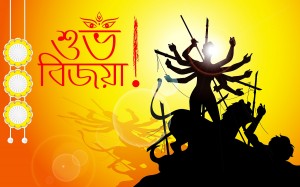
Because the Universal Life Church does not stand between its members and their beliefs, interfaith ministers for the ULC can benefit from understanding important traditions from various religions. Ministers who get ordained may wish to learn about Navaratri, one of the most important holidays in Hinduism. Navaratri is a spiritually significant tradition that involves many universally important beliefs.
The legend behind Navaratri begins with a demon named Mahishasura. Mahishasura impressed Shiva with years of penance and worship, so Shiva made Mahishasura impervious to harm from any man. Only a woman could kill him. The arrogant Mahishasura was sure that no woman could defeat him, and he began a terrible war. Once he had conquered Earth, Mahishasura invaded Indraloka, the abode of the gods. The demon managed to drive the gods out, and they took shelter under Lord Brahma, the god of creation.
Brahma took the gods to Lord Vishnu and Lord Shiva, the other members of the Great Trinity of Hinduism. Vishnu was furious, and he released a great energy in his rage. Shiva woke from his meditation and added to the energy with the light from his third eye. Brahma and the other gods added their power, creating a divine warrior goddess named Durga. Mahishasura was entranced by Durga’s beauty, and he asked her to marry him. She agreed, but only if he could defeat her in battle. The ferocious battle between their armies lasted nine days and nine nights. At the end of the ninth night, Goddess Durga achieved victory by beheading the demon.
The five annual Navaratri celebrations are based on Durga’s battle and victory. The name comes from the nine nights of the battle, which are called Navaratri. This is why Navaratri is a nine night celebration. The most widespread custom of the celebration involves placing images of the goddess in homes and places of worship. Durga’s followers give gifts and sing songs to these images. In North India, people fast during the nine days. There are many festivals during Navaratri, which involve dancing and live music.
Navaratri is popular among Hindus in India and all over the world. This is partially due to the fact that Navaratri is celebrated during times of significant climatic and solar influence. These periods of time are considered to be important times to worship the Divine Mother. Durga is the Divine Mother Goddess in Hinduism because she embodies the protective and empowering aspects of motherhood.
Because people of every faith can get ordained by the ULC, it is a good idea to reflect on the universal significance of the Navaratri celebration. The day after the Navaratri battle is called Vijayadashmi. This day is celebrated after the Navaratri celebration as the day of triumph, when the forces of good managed to defeat evil. The celebration of good beating evil is significant to all faiths. Durga is a symbol of motherhood. People of every faith can understand the association of motherhood with life and growth, which must face the opposite powers of evil and death. An interfaith minsiter can easily share these significant themes with people of all backgrounds.

